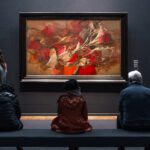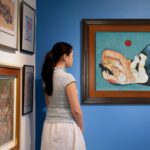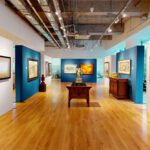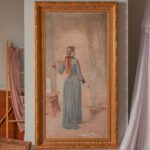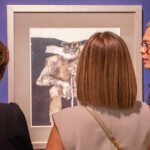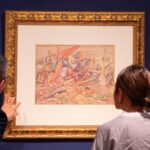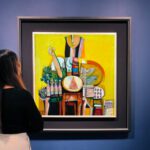
Hidalgo’s Masterpiece ‘Marina’ Crosses the Seas on its Journey Home
- 10 September 2021
Félix Resurrección Hidalgo was born on February 21, 1853, in Binondo, Manila, to wealthy parents— Eduardo R. Hidalgo, a lawyer, and Maria Barbara Padilla, a businesswoman— the third of seven children. The Hidalgos were known to be gracious art patrons, residents of Calle Escolta in Binondo.
In 1871, Hidalgo earned a Bachelor of Philosophy from the University of Santo Tomas in Manila. Eight years later, he was sent to Spain as a pensionado, one whose expenses were paid for by the Spanish colonial government to study abroad. He was enrolled in the Real Academia de Bellas Artes de San Fernando, Madrid. The scholarship required him to accomplish a number of life-sized canvases for his state patrons. Part of the ilustrado elite who left the country in their young adulthood to pursue higher learning overseas, instead of returning to the Philippines at the end of his studies, Hidalgo went to Paris to set up his studio gallery.
Throughout his career, Hidalgo is known to have created several hundred pieces, depicting various subjects mostly favored by the academy: mythological and allegorical tales, historical events, or nude figures in a studio, using materials ranging from oil, pastel, and charcoal on canvas, panel, and paper. A small number of these were in large scale, with the majority sized to hang in drawing room walls.
Many of these oeuvres did not survive the War. The location of many others— we have an idea of the artist’s prolific output based on photographs showing Hidalgo in his studio surrounded by many finished and unfinished works— remains unknown. Owing to the fact that there is no definitive catalogue raisonne on the artist, these pieces have remained lost to history.
In recent years, a scant number of original artworks of unassailable provenance have emerged, the last being La Pintura which was discovered by this writer in the collection of a European family which had held the painting for nearly four generations, until its world-record setting sale at Salcedo Auctions in 2019.
Far from being an artist who did not make a mark during his lifetime, Hidalgo’s talent was widely celebrated, his works collected, portrait commissions coming one after the next; and he was lauded by the leading Salon exhibitions and international art expositions of the day. It is worth noting, for example, that La Pintura was a documented and exhibited artwork, and yet it somehow vanished without a trace until its owners made its existence known.
Amidst the backdrop of this stream of accolades, that an artist such as Hidalgo curiously did not enjoy the same stature as his compatriot Juan Luna y Novicio, speaks volumes not only about the profile that the artist did not so much gain as much as, in our opinion, actively cultivate.
It is a stance that we have an inkling of understanding. It is clear that the artist’s patrician background was one of the sources of his reserve. Detached, outwardly humorless, straight-laced and without even a hint of scandal, one can also see this manifested in the very nature of his works, which provide viewers insight into Hidalgo’s temperament, creative process and ultimately his raison d’etre. It is this core, this world created by Hidalgo in his mind’s eye that he— consciously or not— manifested in his works that we seek to delve further into in this essay.
Hidalgo’s career flourished from the time he entered Virgenes Cristianas Expuestas al Populacho (Christian Virgins Exposed to the Populace) at the National Exposition of Fine Art in Madrid in 1884, where he won a silver medal, vis Luna’s gold. It was this same painting that catapulted him to acclaim in his homeland.
A second painting, a detail study of which is serendipitously offered as Lot 342 in this auction, cemented his renown. TitledLa barca de Aqueronte, this 1887 oil on canvas painting received a gold medal at the Exposicion General de las Filipinas; silver at the 1889 Paris Exposition; a diploma of honor at the 1891 Exposicion General de Bellas Artes in Barcelona, and gold again at the 1893 Madrid Exposicion Internacional de Bellas Artes during the 400th Anniversary of the Discovery of the Americas- making it the expatriate’s most award-winning work. The painting was Hidalgo’s interpretation of Dante’s Inferno, in particular the scene where the damned travel on a boat through the River Acheron, its waters violently buffeting the condemned souls as they are ferried by Charon, the stooped bogeyman dressed in a hooded black cloak, into hell.
It would be roughly seven years from the completion of La barca to the time Hidalgo painted Marina. In that short period, Impressionism, with its focus on capturing moments taken from scenes of everyday life— an effect achieved by the close yet loose application of pigments to approximate the fleeting effect of light on nature, and the way this coalesces in the eye as an image— was gaining many adherents. They painted en plein-air, whereby artists worked outdoors, “captur[ing] the spirit and essence of a landscape or subject by incorporating natural light, color and movement into their works.”
Marina is a painting splendidly executed in this manner. The work captures what would be commonly considered as ‘everyday scenery’ of waves crashing onto craggy rocks along a coastline a seascape that fuses together the sky and ocean, sea foam scattering into mist as rays of sunlight stream out of an opening in the clouds overhead, their appearance like arms stretched out benevolently from the heavens, reaching downwards to calm the waves. By comparison, two other Hidalgo seascapes, one earlier, the other later, bookend Marina in terms of palette and, in turn, atmosphere. When seen together, the three works can be read like the nature cycle, the ebb and flow of time like the tide serving as some form of metaphor about the human condition.
While Mar Revuelto shows a relatively placid outlook starting to be shadowed by gray skies, the aqua colored-currents fading almost to a frothy white to indicate growing inclement conditions, Marina shows a deeper cyan, the color complementing the lavender tones of sky – a vision of a storm that broke and that is just beginning to pass. In contrast, the La Puesta del Sol painted one year after is dominated by dark tones, dusk falling over the scene, its red-orange color adding a sense of the unknown as strong currents continue to crash on the coast.
There is a further metaphor that we see in Marina; and it is one that takes us back to La barca. Look at the manner in which the desperate souls on left of the 1887 masterpiece crest upwards from the bottom center of the canvas to the upper left corner, the wave of crashing bodies destined towards eternal damnation mirrored uncannily by the buffeting currents scattering as they hit the sharp cliffs and stony crags rising out of the water. The similarity however ends here. For while La barca has Charon peering ominously on the right, a figure clothed in black haloed by the fiery red of hell in a scene of horror and the utmost despair, in contrast the salvific symbolism of light streaming from on high could not be more vivid vision of hope.
Marina is a painting whose emergence— just like the sun breaking out to transform the seascape— could not be timelier; and in doing so at this important juncture of our history in the time of pandemic, exuding relevance in as much as it radiates beauty, it is, in our opinion, timeless— a Hidalgo masterpiece in the truest sense of the word.
Provenance
Extensive due diligence was undertaken by Salcedo Auctions to verify the attribution of Marina as an original work by the hand of Felix Resurreccion Hidalgo. Following its provenance, we were able to trace its movement through the original 1926 invoice of the painting which was issued when it was purchased from the Commissaire-priseur— translated as “auctioneer” in English – Feuardent Frères. The letter of receipt, written in French, states: “I received from Madame Maria Luisa Gálatas Vallejo the sum of 2,500 franc for the purchase of a painting made by Félix Resurrección Hidalgo representing a sea landscape, oil on canvas of 81 x 100 centimeters.”
From the back of the painting, a label describes where and when it was exhibited after it was purchased: the renowned Galerie de France in Paris on May 25, 1945. It is marked as Anjou, which our research team has verified to be its former location along the Rue Faubourg Saint Honore at the corner of Rue Anjou. Maria Luisa Gálatas Vallejo owned the painting until 1958. After which time, the Saurin family had possession of Marina until it was sold at auction in Barcelona in 2020, where the present owner acquired the painting.
Top image: A newspaper clipping showing the Commissaire-priseur (auctioneer) Feuardent trading in Paris as early as 1890. Bottom image: Invoice dated ‘Paris, 21 July 1926’ issued by Feuardent Frères for the purchase of Hidalgo’s ‘Marina’ by its former owner, Maria Luisa Gálatas Vallejo. Vallejo would own the painting until 1958.
Expert’s Note The current owner engaged the services of Montse Martí, an expert on 19th century Spanish painting, and the co-author of two scholarly publications on the subject, particularly the period between 1850- 1900, where she wrote the entries on Hidalgo. In her written communication with the present owner, Martí expressed her opinion on the authenticity of Marina based on her familiarity with the works of Hidalgo on stylistic grounds, as well as material findings on the paint, canvas, and the fabrication of the bastidor (stretcher) used for works dating from the time.
References: Alfredo Roces, Felix Resurreccion Hidalgo & the Generation of 1872. Pasig City: Eugenio Lopez Foundation, 1998 Carlos Gonzalez & Montse Martí, Spanish Painters in Rome (1850-1900). Madrid: Sammer, 1988 and Spanish Painters in Paris (1850-1890). Madrid: Sammer/Tusquets, 1989








